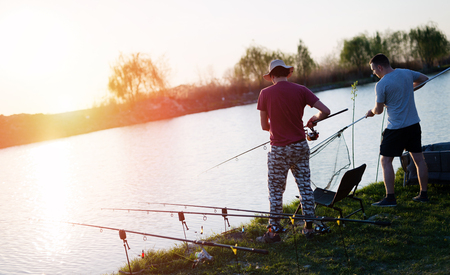1. Mastering the Double Haul
If youre looking to take your fly casting game to the next level, learning the double haul is a must. This technique isn’t just for seasoned pros—it’s a game-changer for anyone who wants to cast farther, cut through wind, or make tight loops with ease. Whether youre fishing high mountain streams or saltwater flats, mastering the double haul opens up new possibilities on the water.
What Is the Double Haul?
The double haul is a fly casting technique where you use your non-rod hand (line hand) to pull on the fly line during both the backcast and forward cast. This added motion increases line speed and helps load the rod more efficiently, giving you extra distance and control.
Why Use It?
Here’s why learning the double haul is worth your time:
| Benefit | Description |
|---|---|
| Increased Line Speed | Allows your fly line to shoot out faster and farther than standard casts. |
| Improved Distance | Makes it easier to reach fish holding farther from shore or boat. |
| Better Wind Performance | Helps punch through headwinds or crosswinds with tighter loops. |
| More Efficient Rod Loading | Maximizes energy transfer into your rod without overpowering it. |
The Mechanics of the Double Haul
The key to a good double haul lies in timing and smooth coordination between your rod hand and line hand. Heres a basic breakdown:
1. The Backcast Haul
As you start your backcast, begin pulling down on the fly line with your line hand. The haul should peak just as the rod reaches the end of its backstroke (around the 1 o’clock position). Then let go or feed line back toward the guides as you prepare for the forward cast.
2. The Forward Cast Haul
Immediately after starting your forward cast, perform another downward pull with your line hand—this time timed with the acceleration of your rod tip moving forward. Release or shoot the line at the end of this motion to maximize distance.
Practice Tips
- Start Slow: Practice each haul separately before combining them into a full double haul.
- Use a Yarn Fly: Reduce risk while practicing by tying on yarn instead of a hook.
- Watch Your Loops: Tighter loops mean better hauls—aim for clean, narrow loops that cut through air efficiently.
- Film Yourself: A smartphone video can help spot timing issues or uneven hauls.
Troubleshooting Common Mistakes
| Mistake | What Happens | How to Fix It |
|---|---|---|
| Poor Timing | Your loop collapses or lacks power. | Synchronize hauls with rod acceleration; don’t rush it. |
| Hauling Too Late | You miss adding energy during key parts of the cast. | Start your haul early in both directions—back and forward. |
| No Line Shoot | Your cast falls short even with a good haul. | Make sure youre releasing (shooting) the line at the right moment. |
When to Use the Double Haul
You don’t always need a double haul, but it really shines in these situations:
- Casting into Wind: Helps maintain loop shape and direction in tough conditions.
- Shooting Long Distances: Essential when fish are spooky or holding far away.
- Casting Heavy Flies: Adds power to handle large streamers or weighted nymph rigs.
- Tight Spots: Generates high line speed with shorter strokes—useful in limited space.
The double haul may seem tricky at first, but once it clicks, youll wonder how you ever fished without it. Stay tuned as we dive into more advanced casting techniques like roll casts and specialty presentation casts in upcoming sections.
2. Roll Cast Refinement
When youre fishing in tight quarters like brushy stream banks or overgrown creeks, the roll cast becomes one of your most valuable tools. Unlike overhead casts that need room behind you, the roll cast works with limited space and helps you keep your fly in the water more often—where it belongs.
Understanding the Roll Cast
A roll cast uses the surface tension of the water to load your rod instead of a traditional backcast. Its ideal when trees, bushes, or rocks prevent a full casting stroke. Mastering this technique allows for precise delivery and better control, even in tough conditions.
Basic Steps for a Roll Cast
| Step | Description |
|---|---|
| 1. Setup | Start with 15-20 feet of line in front of you on the water. Your rod tip should be low and pointing at the fly. |
| 2. D-loop Formation | Slowly lift the rod to bring the line off the water and form a D-shaped loop behind you. |
| 3. Forward Stroke | Accelerate smoothly forward with a firm stop at about eye level, allowing the line to unroll in front. |
Tweaking Your Roll Cast for Tight Spots
In small streams or areas crowded with vegetation, you’ll need to adjust your roll cast technique for better results:
- Shorten Your Stroke: In confined spaces, use a compact motion to avoid hitting obstacles.
- Use a Steeper Angle: Elevating your rod slightly can help create more clearance above surrounding brush.
- Focus on Timing: Let the D-loop fully form before initiating your forward stroke for maximum power and accuracy.
Maintaining Accuracy and Line Control
The key to an effective roll cast isn’t just making the line move forward—it’s sending it where you want it to go. Here are some tips to help:
- Watch Your Rod Tip: Keep your rod tip tracking along a straight path to improve aim.
- Mend Early: After your cast lands, mend immediately if needed to prevent drag and improve fly presentation.
- Select the Right Line: A weight-forward floating line is typically best for easy roll casting.
Pro Tip:
If wind is a factor, try changing your casting angle or body position so the wind helps rather than hinders your D-loop formation.

3. Single-Handed Spey Casts
Single-handed spey casting is a game-changer when youre fishing tight spots or battling tricky river currents. Unlike traditional two-handed spey techniques, this method uses a standard single-hand fly rod, making it perfect for anglers who want to stay light and versatile on the water.
Why Use Single-Handed Spey Casts?
Sometimes you just dont have the room for a big backcast—think overgrown riverbanks, steep canyon walls, or crowded runs. That’s where single-handed spey casts shine. These casts let you reposition your fly without needing much space behind you, which is especially helpful when targeting steelhead or trout in narrow or brushy areas.
Benefits of Single-Handed Spey Casting
| Benefit | Description |
|---|---|
| Minimal Backcast Space Needed | Perfect for tight quarters where traditional overhead casting isn’t possible. |
| Improved Line Control | Makes managing line in strong or variable currents much easier. |
| Versatile Presentation | Allows for smooth roll and change-of-direction casts without spooking fish. |
| Great for Steelhead & Trout | Ideal for swing-style presentations and soft landings in pressured waters. |
Popular Single-Handed Spey Casts to Learn
- Single Spey: A great go-to cast for changing direction with minimal effort.
- Snap T: Useful when you need to reposition your line quickly across the current.
- Perry Poke: A forgiving cast that helps reset your line smoothly after a failed attempt.
- C Switch: Excellent for both left- and right-bank situations when dealing with wind or obstacles.
Tackle Tips
You don’t need special gear to start—just a regular 9-foot 5- to 7-weight rod will do. That said, using a slightly heavier head like a Scandi or short Skagit-style line can help load the rod more efficiently, especially if you’re still getting used to the timing of these casts. Pair it with a matching running line and some tip options like poly leaders or sink tips based on water depth and speed.
Practice Makes Perfect
The key to mastering single-handed spey casting is practice. Start on open water where you can focus on your D-loop formation and anchor placement before moving into tighter spots. Once dialed in, these casts will become second nature and make your time on the river much more productive—especially when targeting elusive species like steelhead hiding in hard-to-reach seams.
4. Casting with Wind and Weather in Mind
When youre fly fishing, weather conditions can make or break your cast. Understanding how to adjust your technique based on wind direction, temperature, and humidity is key to maintaining a consistent and accurate presentation—especially when youre using advanced casting methods like double hauls or roll casts.
Wind Direction: Friend or Foe?
Wind is one of the biggest challenges for fly casters. It can alter the path of your line, affect your accuracy, and even pose safety risks if not managed properly. Heres a quick guide to adjusting your cast depending on the winds direction:
| Wind Direction | Recommended Adjustment |
|---|---|
| Headwind (wind blowing toward you) | Use a tighter loop and faster line speed with a double haul to punch through the wind. Lower your trajectory slightly. |
| Tailwind (wind at your back) | Cast higher on your forward stroke to let the wind carry your line out. Roll casts work well here too. |
| Crosswind (from left or right) | Angle your cast away from the wind. For right-handed casters with wind from the right, consider a cross-body cast or switch to casting left-handed. |
Temperature’s Impact on Line and Leader
Temperature affects both your fly line and leader material. In colder weather, lines can stiffen and become less responsive, while warmer temps make them more supple but sometimes too soft. Adjusting your casting stroke to accommodate these changes helps maintain control:
- Cold Weather: Use smoother, slower casting strokes to avoid tangles caused by stiff line memory.
- Hot Weather: Speed up your stroke slightly if the line becomes too limp or sticky in the guides.
The Role of Humidity in Presentation
You might not think about humidity affecting fly casting, but it plays a subtle role—especially in dry fly presentations. High humidity can make flies heavier due to moisture absorption, while low humidity may cause them to float higher than expected.
- High Humidity: Consider using slightly lighter tippet or more buoyant flies to counteract water weight.
- Low Humidity: Watch for quicker drifts; you may need to mend more frequently to maintain natural presentation.
Tying It All Together on Variable Days
The real challenge comes when multiple weather factors are at play. Imagine casting into a headwind on a cold, humid morning—your line is stiff, flies are damp, and accuracy is tough. Thats when understanding how all these elements interact becomes crucial.
Quick Tips for Mixed Conditions:
- Double haul often: Adds power and control when conditions are unpredictable.
- Roll cast when space is limited: Especially useful when wind makes overhead casts tricky.
- Keep an eye on your loops: Tight loops cut through wind better; open loops may help with delicate presentations in calm spots.
Mastering how to read and react to changing weather will not only improve your advanced casting techniques—itll keep you fishing confidently no matter what nature throws your way.
5. Advanced Presentation Techniques
Once youve mastered the basics of fly casting, its time to level up with advanced presentation techniques that can make all the difference when targeting picky or pressured fish. These techniques help improve your fly placement, reduce drag, and increase your chances of getting a strike—especially from selective trout and other wary species.
Reach Casts
The reach cast is a go-to technique when youre dealing with tricky currents that can pull your fly unnaturally fast. Right after your forward cast but before the line lands, you move your rod tip upstream (for right-handed anglers, this usually means to the left). This motion places more slack upstream of your fly, helping it drift more naturally.
When to Use a Reach Cast
- When fishing across multiple current seams
- To extend drag-free drift time
- When presenting dry flies to rising trout
Curve Casts
A curve cast lets you bend your line around obstacles or position your fly in a specific spot without spooking fish. By adjusting your wrist and arm movement during the final part of the forward stroke, you can cause the line to curve left or right.
Tips for Curve Casting
- Use more sidearm motion for greater curve
- Snap your wrist at the end of the forward cast to exaggerate the bend
- Practice both left and right curves to adapt to different riverbanks and cover
S-Cast (Slack Line Cast)
The S-cast is all about dropping slack into your line on purpose. After your forward cast, wiggle your rod tip side-to-side as the line unrolls. This creates an S-shape on the water’s surface, allowing the fly to drift naturally before tension sets in.
Great For:
- Fishing spooky trout in slow-moving water
- Presenting small dries with minimal splash
- Extending natural drift time on flat pools
Presentation Techniques Quick Reference Guide
| Technique | Main Benefit | Best Used When… |
|---|---|---|
| Reach Cast | Reduces drag by positioning line upstream | Casting across conflicting currents |
| Curve Cast | Puts fly behind cover or around obstacles | You need to get behind rocks or logs without lining fish |
| S-Cast | Adds slack for longer natural drifts | Targeting spooky fish in slow water conditions |
Troubleshooting Your Presentations
If youre not getting takes even with accurate casts, the issue might be presentation. Try varying your casting angle, adding slack with reach or S-casts, or changing where your leader lands. Sometimes just a little extra finesse makes all the difference.
Pro Tip:
If youre practicing these casts on water, use visible dry flies so you can clearly see how changes in casting affect drift and presentation.


